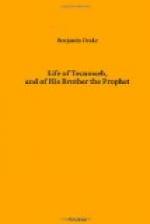prepared by the Indians. Here the old man knelt
down, and in an elevated but solemn tone of voice,
addressed his prayer to the Great Spirit. As soon
as he had finished, the captain of the Indians knelt
beside him, and prayed in a similar manner. Their
prayers of course were spoken in the Wyandot tongue.
* * * * After a few moments delay, the prisoner again
sank down upon his knees and prayed as he had done
before. When he had ceased, he still continued
in a kneeling position. All the rifles belonging
to the party had been left at the wigwam. There
was not a weapon of any kind to be seen at the place
of execution, and the spectators were consequently
unable to form any conjecture as to the mode of procedure,
which the executioners had determined on, for the
fulfilment of their purpose. Suddenly one of the
warriors drew from beneath the skirts of his capote,
a keen, bright tomahawk—walked rapidly
up behind the chieftain—brandished the weapon
on high, for a single moment, and then struck with
his whole strength. The blow descended directly
upon the crown of the head, and the victim immediately
fell prostrate. After he had lain awhile in the
agonies of death, the Indian captain directed the
attention of the white men to the drops of sweat which
were gathering upon his neck and face; remarked with
much apparent exultation, that it was conclusive proof
of the sufferer’s guilt. Again the executioner
advanced, and with the same weapon, inflicted two
or three additional and heavy blows. As soon as
life was entirely extinct, the body was hastily buried,
with all its apparel and decorations; and the assemblage
dispersed."[A]
[Footnote A: Mr. Otway Curry, in the Hesperian
for May, 1838.]
One of Mr. Heckewelder’s correspondents, as
quoted in his Historical Account of the Indian Nations,
makes Tarhe, better known by the name of Crane, the
leader of this party. This has been denied; and,
the letter[A] of general Harrison on the subject,
proves quite conclusively that this celebrated chief
had nothing to do with the execution of Leatherlips.
Mr. Heckewelder’s correspondent concurs in the
opinion that the original order for the death of this
old man, was issued from the head quarters of the
Prophet and his brother.
[Footnote A: Published in the Hesperian for July,
1838.]
CHAPTER VII.
Governor Harrison makes another effort to ascertain the designs of
Tecumseh and the Prophet—Tecumseh visits the governor at Vincennes,
attended by four hundred warriors—a council is held—Tecumseh
becomes deeply excited, and charges governor Harrison with
falsehood—council broken up in disorder—renewed the next day.




